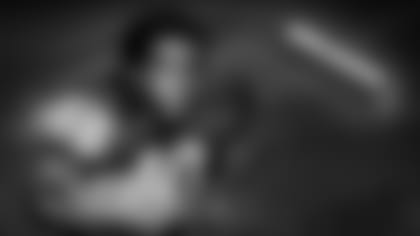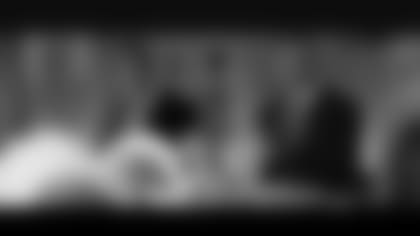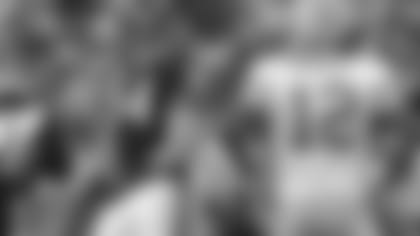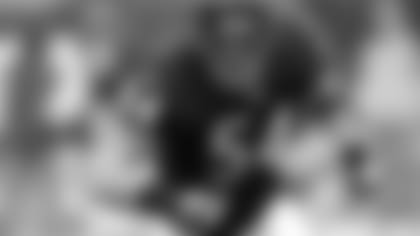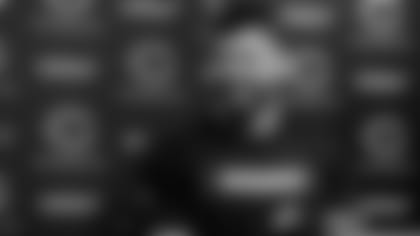With the NFL Draft just a few days away, I rank the top four drafts in Bears history:
1) 1983
With two first-round picks, the Bears entered the 1983 NFL Draft with high expectations. Twelve rounds later, they had harvested seven eventual starters who in two years would help lead the franchise to its first Super Bowl title.
The draft class included tackle Jimbo Covert and receiver Willie Gault in the first round, cornerback Mike Richardson in the second, safety Dave Duerson in the third, guard Tom Thayer in the fourth and Hall of Fame defensive end Richard Dent and guard Mark Bortz in the eighth.
The Bears selected Covert with the sixth overall pick, two slots after the player that they had been targeting, Northwestern offensive lineman Chris Hinton, was chosen by the Broncos.
Before taking Covert, Bears general manager Jim Finks had considered Clemson safety Terry Kinard, who went 10th to the Giants; and Illinois quarterback Tony Eason, who went 15th to the Patriots.
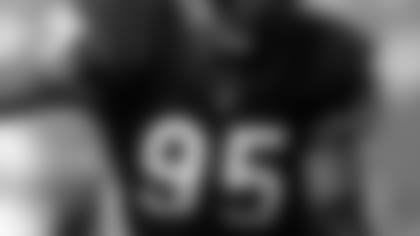
Defensive end Richard Dent was MVP of Super Bowl XX and inducted into the Hall of Fame in 2011.
Jim McMahon, the Bears' first-round pick the previous season, wondered why the team was looking at Eason. "I plan on playing, so I don't know what they would have done with him," McMahon said after the draft.
The Bears selected Gault at No. 18 after the Falcons chose Alabama defensive end Mike Pitts at No. 16 and the St. Louis Cardinals picked McNeese State safety Leonard Smith at No. 17.
McMahon was more pleased with the arrival of Covert than Gault. "What good is a fast receiver if you can't set up and throw it to him?" McMahon said.
Covert, who blocked for Hall of Fame quarterback Dan Marino at the University of Pittsburgh, anchored a stellar Bears offensive line for eight seasons. A two-time Pro Bowler, Covert fought through chronic back problems throughout his career in Chicago.
"He's good at setting up short and stopping ends from the left side," coach Mike Ditka said the day Covert was drafted. "In films, he looks like he was toying with people."
Gault, a world-class sprinter from Tennessee who was the first receiver chosen in the 1983 draft, caught 184 passes in five seasons with the Bears. He currently ranks ninth on the club's all-time list with 3,650 receiving yards.
"We had problems with the way people played us outside last year," Ditka said at the time. "We think Willie can have the same impact on the Bears as Bob Hayes had on the Cowboys and James Lofton had on the Packers. We're looking to become a fast football team."
In the days leading up to the draft, the Los Angeles Raiders had been trying to trade for the Bears' No. 6 pick. The Raiders wanted to use the pick as part of a package to acquire the first overall selection from the Baltimore Colts to land Stanford quarterback John Elway.
But the deal fell through, reportedly because the Raiders felt that the Bears were asking for too much in return. Owner Al Davis denied speculation that the Raiders had offered future Hall of Fame defensive tackle Howie Long and cornerback Ted Watts for Chicago's No. 6 pick.
In Richardson, the Bears chose an athlete "with great presence," according to scout Jim Parmer. Primarily a safety at Arizona State, Richardson made a successful transition to cornerback in the NFL.
Covert, Gault and Richardson all were immediate starters for the Bears.
Duerson was a versatile four-year starter at Notre Dame. He was initially projected as a cornerback, but remained at safety and was selected to four Pro Bowls in seven seasons with the Bears.
The Bears were embarrassed to learn that they had drafted Thayer a few hours after he had signed with the Chicago Blitz of the rival United States Football League. But the Joliet product eventually joined the Bears in 1985 and started for the Super Bowl champions.
The Bears had traded away their picks in the fifth, sixth and seventh rounds, so they sat and watched before striking gold twice in the eighth round.
Scout Bill Tobin said that Dent was the best pure pass rusher he had graded. But Dent hadn't played against top competition at Tennessee State. He also weighed just 224 pounds due in part to a problem with his teeth that limited what he could eat.
All Dent did was develop into a monster pass-rusher, becoming the Bears' all-time leader with 124.5 sacks. He was named MVP of Super Bowl XX and inducted into the Hall of Fame in 2011.
Bortz wasn't too shabby either. Called "tough and a battler" by Ditka, Bortz was converted to offense after playing defensive tackle at Iowa and would join Covert, Thayer, center Jay Hilgenberg and tackle Keith Van Horne to form one of the best offensive lines in NFL history.
2) 1965
One was a ferocious middle linebacker, an intimidating and relentless force who possessed talent, aggression and hostility. The other was an electrifying and elusive running back who was a threat to go the distance every time he touched the ball.
The differences between Dick Butkus and Gale Sayers were obvious, but the similarities remain just as striking. The superstars arrived with back-to-back picks in the 1965 NFL Draft, dominated as rookies and became Bears legends who are still revered by fans more than 50 years later.
Their brilliant careers were shortened by knee injuries, but Butkus and Sayers both ultimately were inducted into the Pro Football Hall of Fame. They even stood side-by-side when the Bears retired their numbers during a Monday night game against the Packers in 1994.
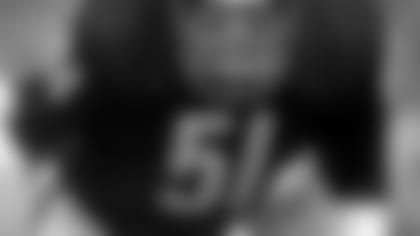
Middle linebacker Dick Butkus remains one of the greatest defensive players in NFL history.
With the first pick in the 1965 draft, the New York Giants considered Butkus before choosing Auburn's Tucker Frederickson "because he is the best all-around fullback in the country," Giants vice president Wellington Mara said at the time.
After the San Francisco 49ers selected North Carolina running back Ken Williard, the Bears chose Butkus third with a pick they had acquired in a trade with the Pittsburgh Steelers and Sayers fourth with the selection they had received after finishing 5-9 in 1964.
After the Dallas Cowboys drafted California quarterback Craig Morton fifth overall, the Bears chose Tennessee defensive lineman Steve DeLong at No. 6 with a pick they had acquired from the Washington Redskins.
"As far as we're concerned, we got the No. 1, 2 and 3 college football players in the country," said Bears president George "Mugs" Halas Jr., the son of the legendary Bears founder and owner. "We would have been happy if two of the three had been left for us."
The Bears' 1965 draft class also included seventh-round selection Dick Gordon, a Michigan State running back who developed into a two-time Pro Bowl receiver in Chicago.
DeLong opted to sign with the rival American Football League and played his first seven pro seasons with the San Diego Chargers before finally joining the Bears for one year in 1972.
Chicago's other two first-round picks, however, became immediate stars.
Sayers, who set an NFL record with 22 touchdowns and tied another mark by scoring six TDs in a remarkable performance against the 49ers, edged Butkus for Rookie of the Year honors.
Sayers came to the Bears after starring at the University of Kansas. In Sayers, the Bears were hoping that they had drafted a breakaway successor to the late Willie Galimore, a star running back who had been killed in an automobile accident the previous summer at training camp.
"I've looked at Sayers in 12 games and he has some moves that even Willie didn't," Bears assistant coach George Allen said at the time. "And he's a track man, too; a hurdler. This is an indication that he has something more than just straight-ahead speed."
Kansas athletic director Wade Stinson told the Chicago Tribune that "Sayers is the best broken field runner I've ever seen. He'll show you moves you haven't seen yet."
Forced to retire after a second knee injury, Sayers set 23 club records and seven NFL marks during seven seasons with the Bears. He was selected to five Pro Bowls and was named Offensive MVP in three of the games.
In 1977, at the age of 34, Sayers became the youngest man ever inducted into the Hall of Fame. His effective playing time is also the shortest of any Hall of Famer.
Butkus, meanwhile, remains one of the greatest defensive players in NFL history. He was selected to eight Pro Bowls in nine seasons and set a Bears record with 47 takeaways (25 fumble recoveries and 22 interceptions).
With the fledgling AFL boosted by a lucrative television contract with NBC, the NFL faced stiff competition to sign players that were drafted by both leagues. Butkus was also chosen by the Denver Broncos, an AFL franchise that was rumored to be preparing to relocate to Chicago.
George Halas was confident that the Bears would be able to sign the Chicago native.
"We've been after Butkus ever since last year when he led Illinois to the Big Ten title," the Bears coach said after the draft. "We've got to have him. He's a great one."
3) 1936
The careers of Joe Stydahar and Danny Fortmann were intertwined even before they were both selected by the Bears in the first NFL Draft in 1936.
Stydahar, a big and powerful tackle from West Virginia, and Fortmann, a small but talented guard from Colgate, started together in the East-West Shrine Game in San Francisco and then played in the College All-Star Game in Chicago before joining the Bears.
Playing next to each other on the left side of the Bears offensive line, Stydahar and Fortmann helped the "Monsters of the Midway" revolutionize pro football with the T-formation.
Each man won three league championships as part of a Bears dynasty in the 1940s, served in the military during World War II and was eventually inducted into the Pro Football Hall of Fame.
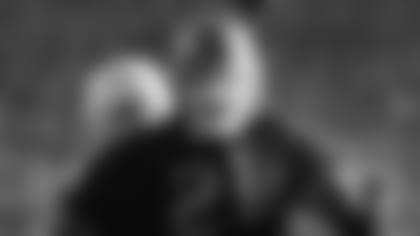
Guard Danny Fortmann earned all-NFL honors for six straight seasons from 1938-43.
"It helped me tremendously to play next to Joe for so many years," Fortmann once said. "A true partnership built up. We got to know exactly what to expect from one another."
With the sixth overall pick in the inaugural draft, George Halas and the Bears selected Stydahar, who at 6-4 and 233 pounds was huge for his era. Stydahar played nine seasons with Chicago, interrupted by a two-year stint in the U.S. Navy in 1943-44.
A two-way star who played without a helmet early in his career, Stydahar was named all-NFL for four straight seasons from 1937-40. He was part of the Bears team that annihilated the Washington Redskins 73-0 in the 1940 title game, a contest that remains the most lopsided in NFL history.
Playing two more seasons after returning from the Navy, Stydahar retired after helping the Bears defeat the New York Giants 24-14 in the 1946 NFL Championship game.
Stydahar, who later served as an assistant coach on the Bears' 1963 title team, was inducted into the Hall of Fame in 1967. He passed away on March 23, 1977 at the age of 65.
Without the sophisticated scouting that exists today, legend has it that Halas chose Fortmann in the ninth and final round of the inaugural NFL Draft because Papa Bear liked the player's name.
Standing just six-feet tall and weighing 210 pounds, Fortmann was small for an offensive lineman even by 1930s and '40s standards. But that didn't stop him from earning all-NFL honors for six straight seasons from 1938-43.
As a rookie in 1936, Fortmann was the youngest starter in the NFL at the age of 20. Halas allowed Fortmann, a Phi Beta Kappa scholar, to attend medical school while he played for the Bears and he graduated from the University of Chicago School of Medicine in 1940.
"Without George's understanding and cooperation," Fortmann once said, "I could have never prepared for my future."
Fortmann retired from football and entered the Navy in 1943 after helping the Bears win three NFL championships in four seasons. In 1965, he became just the second guard ever to be elected to the Hall of Fame. Fortmann passed away on May 23, 1995 at the age of 79.
4) 1975
He played at tiny Jackson State University, but Walter Payton was hardly an unknown commodity when he was chosen by the Bears with the fourth pick in the 1975 draft.
Payton was a two-time first-team All-American who set the NCAA scoring record with 464 points, established nine school records and received votes for the Heisman Trophy.
"He wasn't any deep secret," then-Bears head coach Jack Pardee said on Jan. 28, 1975, the day Payton was drafted. "Everyone in the country knows about him."
Maybe so, but few imagined that Payton would become the NFL's all-time leading rusher and arguably the greatest player in Bears history. Then again, the man they called "Sweetness" was seemingly convinced that he would enjoy a special career in the Windy City.
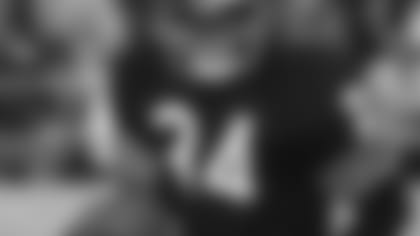
Running back Walter Payton was chosen by the Bears with the fourth pick in the 1975 draft.
"When I get through with Chicago, they'll be loving me," Payton said the day he was drafted.
The Bears selected eight other players in 1975 who would eventually start: defensive end Mike Hartenstine (second round), cornerback Virgil Livers (fourth), guard Revie Sorey (fifth), quarterback Bob Avellini (sixth), linebacker Tom Hicks (sixth), defensive tackle Roger Stillwell (ninth), safety Doug Plank (12th) and fullback Roland Harper (17th).
"We certainly did one thing," legendary Bears owner George Halas said at the time. "We helped our needs. I'm so enthused with the whole thing. I think it's the finest Bear draft in 10 years."
Halas sat in on the two-day session, but was primarily a spectator. The draft was orchestrated by general manager Jim Finks, who joined Papa Bear in the Pro Football Hall of Fame in 1995.
Heading into the draft, running back was considered the Bears' most pressing need. Ken Grandberry had led the team in rushing in 1974 with just 475 yards and two touchdowns on 144 carries.
Many scouts felt that Texas A&I's Don Hardeman was the best runner available. But Hardeman was selected by the Houston Oilers with the 15th pick and rushed for only 1,460 yards and 11 touchdowns on 397 carries in five NFL seasons with the Oilers and Baltimore Colts.
The three players chosen ahead of Payton were quarterback Steve Bartkowski (Atlanta Falcons), defensive tackle Randy White (Dallas Cowboys) and guard Ken Huff (Colts).
The only Hall of Famers from the 1975 draft are Payton, White and defensive end Fred Dean, who was selected by the San Diego Chargers in the second round (33rd overall).
The Bears insisted that they would have selected Payton if they had the No. 1 pick. When the Colts chose Huff, Pardee revealed that "a nice cheer went up" in Chicago's draft room.
"We've been sweating it out all night," he said. "What happened is what we were hoping for. Had we been in Atlanta's spot, we'd have chosen Walter Payton. We thought that much of him."
The next day, the Chicago Tribune speculated that "Payton's addition raised immediate doubt about the future of (incumbent running back) Carl Garrett with the Bears."
Finks landed two more offensive starters by making draft-day trades.
The Bears general manager dealt third- and seventh-round selections to the Colts for the rights to tight end Greg Latta, Baltimore's 1974 first-round pick who had played his rookie season for Pardee in the World Football League with the Florida Blazers.
Finks sent another seventh-round choice to the Colts for the rights to guard Noah Jackson, who had played out his option with the Toronto Argonauts in the Canadian Football League.


